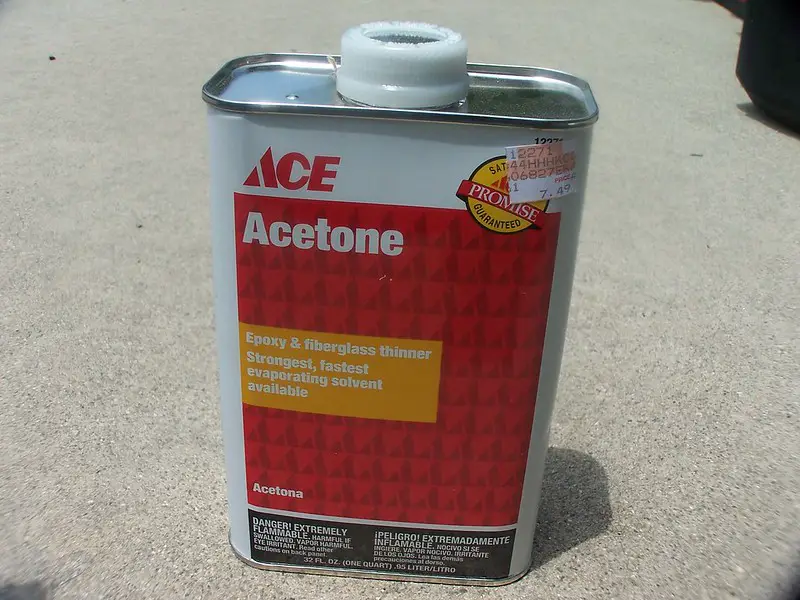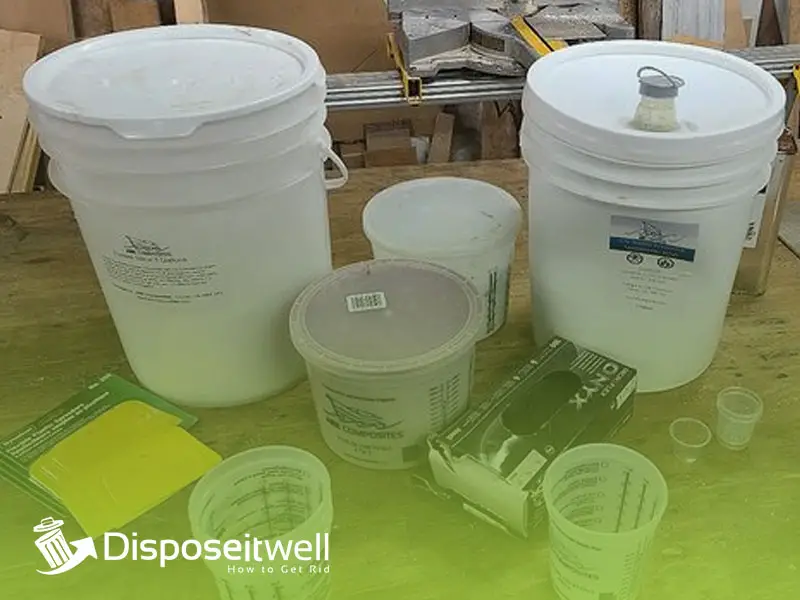Did you know that acetone is a colorless, volatile, and flammable liquid with a characteristic odor? It is the simplest ketone and has the formula CH3COCH3.
Acetone is miscible with water and ethanol in all proportions. Inhalation of acetone can cause dizziness, headache, nausea, and vomiting. Long-term exposure to high levels of acetone may cause weight loss, central nervous system damage, or liver problems.
Acetone can be harmful to the environment if disposed of improperly. It is important to know that acetone can be very hazardous and must be managed correctly. This article will discuss how to dispose of acetone safely and responsibly.
What is Acetone?
Acetone is a colorless, flammable liquid with a strong pungent odor. It is the simplest and smallest ketone. It is miscible with water and is used as a solvent for cleaning purposes and in the manufacture of various chemicals. It is also used in many household and industrial products, including nail polish remover, paint thinner, and superglue remover.
Is Acetone Hazardous?
Yes, acetone is hazardous. It is a volatile organic compound that can evaporate quickly, and when inhaled, it can cause dizziness, headaches, and nausea. Acetone is also flammable, so it should be kept away from heat and open flames.
Exposure to acetone can cause irritation to the skin, eyes, and respiratory tract. Inhaling large amounts of acetone can also lead to dizziness, headaches, and nausea. Ingestion of acetone can cause vomiting and abdominal pain.
Acetone is a flammable liquid, so it’s important to keep it away from heat or flames. Fire and explosion hazards exist when acetone is used or stored near heat, flame, or other ignition sources.
Acetone should be stored in well-ventilated, fire-resistant containers away from heat, sparks, and open flames. If you are using products that contain acetone, it is important to read the label carefully and follow the directions for safe use.

Acetone Safety Tips while Disposing
While disposing of acetone, one should always take safety precautions in order to avoid any potential accidents and the environment. Here are some tips to follow:
- Wear proper Personal Protective Equipment (PPE), including gloves, goggles, and a respirator mask.
- Place the acetone in a container that is properly labeled and compatible with the material.
- Make sure the container is sealed before disposing of it in the appropriate waste stream.
- If possible, reuse or recycle the acetone instead of disposing of it.
- Keep acetone away from open flames or other sources of ignition.
- Do not dispose of acetone down the drain or in the garbage.
- Check with your local authorities for instructions on how to dispose of acetone properly.
How To Dispose of Acetone?
Assuming you have a large quantity of acetone that you need to dispose of, there are a few methods you can use to safely get rid of it.

1. Evaporation
Evaporation is the most common way to dispose of acetone because it is easy and inexpensive. When disposing of acetone by evaporation, pour the acetone into an open container such as a pan or tray and allow it to evaporate in a well-ventilated area away from ignition sources. The evaporation process will take several hours to complete.
Note: Always use this method in a well-ventilated area.
2. Absorption
Acetone can also be absorbed by using absorbent materials such as kitty litter, sand, or vermiculite. Place the absorbent material in a sealable container such as a bucket or drum and pour the acetone into the container until it is completely full. Once the acetone has been absorbed, seal the container and dispose of it according to your local regulations.
3. Incineration
The first method is incineration, which is when the acetone is burned at a high temperature. This is generally considered the most effective way to dispose of acetone, as it will completely break down the chemical into harmless gases.
However, incineration is also the most expensive method, as it requires special equipment and facilities. If you have a large quantity of acetone to dispose of, it might be worth considering this option.
4. Trashing out
When disposing of acetone, it is important to follow the proper procedures to ensure that it does not end up in an environment where it can cause harm.
The first step is to neutralize the acetone with a base such as sodium bicarbonate (baking soda). This will help to prevent the release of Volatile Organic Compounds (VOCs) into the atmosphere. Once the acetone has been neutralized, it can be disposed of in the regular trash.
It is also important to note that acetone should never be poured down the drain as it can contaminate water supplies and damage septic systems.
If you have large quantities of acetone that need to be disposed of, store it in large air-tight containers and contact your local hazardous waste disposal facility to take them.
5. Chemical Treatment
Chemical treatment systems can be used to break down acetone before it is discharged into sewers or other bodies of water. These systems use activated carbon filters and bio-reactors to remove harmful toxins from the wastewater.
6. Landfill Disposal
This is also a good option for disposing of acetone in landfill disposal. This is the least desirable option as it can potentially leach into groundwater and contaminate aquatic ecosystems. If disposing of acetone in a landfill, be sure to properly package the acetone in sealed containers with labels indicating its contents.
7. Recycling
Acetone can also be recycled for reuse. Recycling acetone helps to reduce waste and conserve resources. Common methods of recycling acetone include distillation, pyrolysis, steam cracking, adsorption, and thermal oxidation.
8. On-Site Septic Tank
If you have an on-site septic tank, contact your local environmental health department and determine if the acetone can be safely discharged into the tank. If it cannot, contact a hazardous waste disposal service for proper disposal techniques.
It is important to note that acetone should never be poured directly into the environment or any body of water as it can cause serious damage. Always take precautions when disposing of acetone and follow the proper procedures outlined above. By doing so, you will help to reduce environmental contamination and keep our waterways safe.
Can You Reuse Acetone?
Acetone can be reused as long as it is not contaminated with other chemicals. To reuse acetone, it must be distilled first to remove impurities and then filtered to remove any remaining contaminants. Acetone can be reused for cleaning, dissolving, and thinning materials such as paint and adhesives. Acetone is a powerful solvent, so it should be handled with care and stored in an airtight container to prevent evaporation.
How To Store Acetone?

To store the Acetone follow the following instructions:
- Acetone should always be stored in a cool, dry place away from direct sunlight, and it should also be kept out of the reach of children and pets.
- It should be stored in its container with the lid tightly closed to prevent any spills or evaporation.
- Acetone containers should never be stored near any other flammable substances, and they should not be stored in a refrigerator or freezer.
- Proper storage of acetone will help ensure safety and minimize the risk of it being mishandled. The container should also be labeled clearly with the name “acetone” to prevent any confusion or accidental use of the chemical.
- If acetone is being used for an extended period of time, it should be stored in a cool, dry place to prevent evaporation.
Proper storage and handling of acetone will help ensure safety and minimize the risk of any harm caused by accidental use or exposure.
Can we store Acetone in a plastic container?
Yes, you can store acetone in a plastic container. However, it is important to make sure that the container is made of a material that is resistant to chemical deterioration and compatible with acetone.
Plastic containers made of HDPE (high-density polyethylene), PVC (polyvinyl chloride), and PET (polyethylene terephthalate) are all suitable for acetone storage. It is still important to be aware of the potential hazards that may arise from storing chemicals, even if they are in an appropriate container.
Can you drain down Acetone?
No, you cannot drain down acetone, this would be a really bad idea. Acetone can react with certain materials that are often found in plumbing systems, such as rubber or some kind of plastic components and it could cause them to degrade or even melt. This could lead to further damage to your pipes and potentially costly repairs.
In addition, using acetone in plumbing could lead to an environmental hazard. Acetone can easily contaminate the water supply and is toxic when ingested by humans or animals. Therefore, using it in a plumbing system could have serious consequences.
But if you have a small amount of acetone that needs to be disposed of, it is best to do so in an appropriate manner.
READ ALSO: How To Dispose Of Rubbing Alcohol
Conclusion
Acetone is a widely used solvent with many benefits, but it must be disposed of properly to avoid harming the environment.
Also, Acetone is an essential industrial solvent and can be a valuable resource if handled properly. By following the guidelines outlined above, you can help to ensure that acetone is disposed of in a safe and responsible manner. Remember, when in doubt, always contact your local hazardous waste disposal facility for assistance!
Together we can make a difference and protect our environment for future generations. Thank you for doing your part!

Gemma Alexander has an M.S. in urban horticulture and a backyard filled with native plants. After working in a genetics laboratory and at a landfill, she now writes about the environment and recycling topics.

